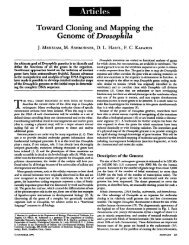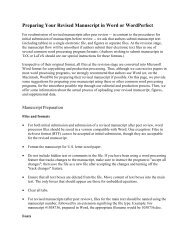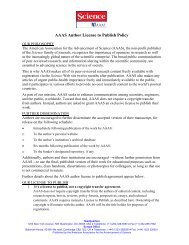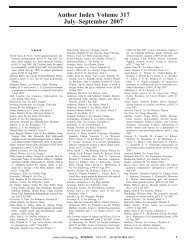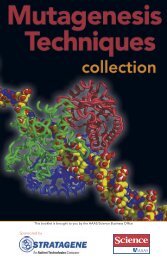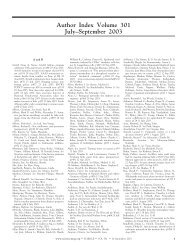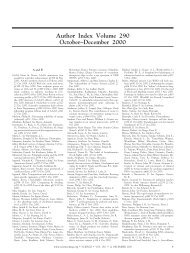Chinese Academy of Sciences (PDF) - low res version
Chinese Academy of Sciences (PDF) - low res version
Chinese Academy of Sciences (PDF) - low res version
Create successful ePaper yourself
Turn your PDF publications into a flip-book with our unique Google optimized e-Paper software.
CREDIT: COURTESY OF CAS<br />
Research CAS/In Focus<br />
Figure 1. Different measu<strong>res</strong> for cooling <strong>of</strong> the Qinghai-Xizang Railway roadbed: (A) thermosyphons;<br />
(B) shading-board; (C) ventiduct embankment; (D) crushed rock covered embankment;<br />
(E) crushed rock-based embankment; and (F) bridge substituting for embankment.<br />
Resource and Environment<br />
Research<br />
Resource and environment <strong>res</strong>earch is considered one <strong>of</strong> the most important<br />
components in modern science and technology for creating a solid<br />
foundation for sustainable socio-economic development. It covers the <strong>res</strong>earch<br />
areas <strong>of</strong> geology, geophysics, geodesy, geochemistry, atmospheric<br />
science, oceanology, geography, environment science, <strong>res</strong>ource science,<br />
remote sciences, and ecology. Under the <strong>Chinese</strong> <strong>Academy</strong> <strong>of</strong> <strong>Sciences</strong><br />
(CAS) framework, there are a total <strong>of</strong> 27 institutes focusing on this area,<br />
with an aggregate <strong>res</strong>earch workforce <strong>of</strong> over 7,000 permanent staff, more<br />
than 1,000 temporary staff, and nearly 7,000 graduate students. There are<br />
20 state key laboratories generating observational data: five field station<br />
networks—including the <strong>Chinese</strong> Ecosystem Research Network (CERN),<br />
the <strong>Chinese</strong> Special Environment and Disaster Research Network (SEDN),<br />
the CAS Offshore Marine Observation and Research Network, and the<br />
Solar-Ter<strong>res</strong>trial Space Environmental Observation Network and Global Atmosphere<br />
Watch (CAS-GAW)—as well as a number <strong>of</strong> ships carrying out<br />
scientific investigations.<br />
Solid Earth Science<br />
CAS scientists have made great strides in palaeontology and stratigraphy,<br />
continental dynamics and deep earth processes, and quaternary and<br />
global changes as well as studies <strong>of</strong> hydrocarbon <strong>res</strong>ources and mineral<br />
<strong>res</strong>ources.<br />
Example: Palaeontology and Stratigraphy<br />
CAS scientists have made exciting prog<strong>res</strong>s exploring the origins <strong>of</strong> life<br />
and understanding the coevolution <strong>of</strong> humans and their natural environment.<br />
Stratigraphic studies have shed light on the paleontological mystery<br />
<strong>of</strong> the Cambrian Explosion, known as one <strong>of</strong> the “top 10 scientific<br />
conundrums” among the international science community. Seven <strong>of</strong> 10<br />
“golden spikes” (GSSP)—exact points<br />
in geological time—in China have been<br />
defined by CAS scientists, positioning<br />
China as a global leader in stratigraphy.<br />
Studies on the origin and evolution <strong>of</strong><br />
vertebrate taxa have al<strong>low</strong>ed existing<br />
hypotheses to be modified and improved<br />
and provided data to clarify the<br />
origin and early evolution <strong>of</strong> some important<br />
vertebrate categories.<br />
Geographical Science<br />
CAS <strong>res</strong>earch in the geographical sciences<br />
focuses mainly on the scientific exploration<br />
and investigation <strong>of</strong> national natural<br />
<strong>res</strong>ources, geographic differentiation,<br />
geographical processes, land and water<br />
<strong>res</strong>ources, and regional spatial development<br />
and regional planning as well as remote<br />
sensing and geographic information<br />
technology.<br />
Example: Geographical<br />
Processes<br />
Comprehensive and systematic <strong>res</strong>earch<br />
has been conducted on<br />
geographical processes, such as<br />
transformation processes in the atmosphere-surface-soil-groundwater<br />
cycle, surface processes related to<br />
soil erosion and land use, cryosphere<br />
CAS scientists have<br />
made exciting<br />
prog<strong>res</strong>s exploring<br />
the origins <strong>of</strong> life<br />
and understanding<br />
the coevolution<br />
<strong>of</strong> humans and<br />
their natural<br />
environment.<br />
17



